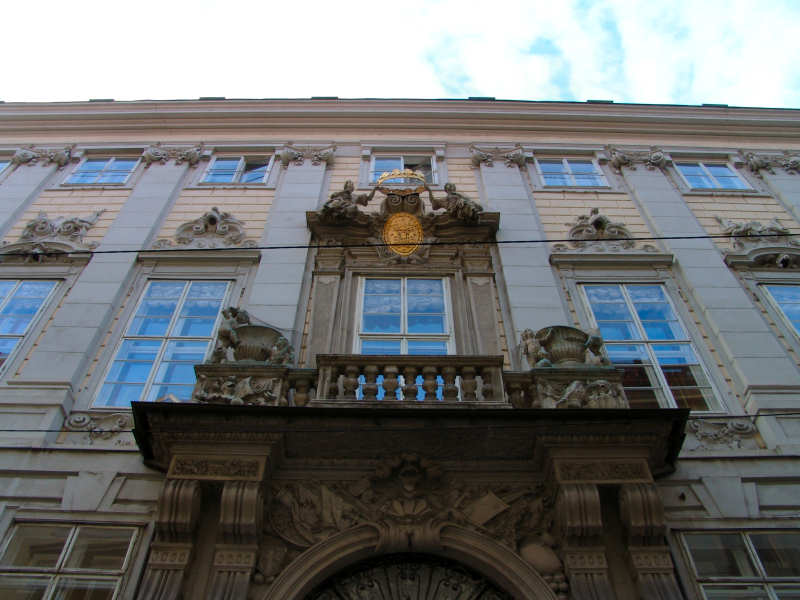Federal Ministry of Finance

Himmelpfortgasse, 1010 Vienna
Himmelpfortgasse 6-8b and Johannesgasse 5-5a, former Winter Palace of Prince Eugene and former Questenberg-Kaunitz Palace (690.150)
Winter Palace of Prince Eugene
According to an extract from the land register from the year 1754, Prince Eugene of Savoy (1663–1736) slowly began to acquire four properties along the former Trabothengasse Alley (today: Himmelpfortgasse Alley). In 1696, he commissioned the architect Johann Bernhard Fischer von Erlach with a new building. The main tract was erected in 1697 and included seven window axes and a portal. During this phase, a collaboration took place between Johann Bernhard Fischer von Erlach, sculptor Giovanni Giuliani (who created the marvellous atlases along the lower flight of the staircase) and plasterer Santino Bussi. The staircase itself is a masterpiece due to its impressive effect achieved within the smallest space available. Prince Eugene acquired his third property on April 2nd, 1702, which created the necessary conditions for a generous extension of the Palace leading to 12 window axes and two portals. The side tract was finished by Johann Lucas of Hildebrandt in 1711.
It was not until July 20th, 1719, that the Prince managed to buy his fourth property in Himmelpfortgasse Alley. It was between 1723 and 1724 when the library tract and its five axes were built by Johann Lucas von Hildebrandt. After this, the Palace received its present form counting 17 window axes and three portals. From the beginning, the Winter Palace was not exclusively meant as a private apartment. It is where the landlord, in his role as the President of the Court Counsel of War, received official diplomatic delegations and where council meetings were held and treaties signed.
On the night of April 20th, 1736, Prince Eugene died of lung disease in his Winter Palace. In 1752, the building was acquired by Maria Theresa (1717–1780) and adapted to be used for official purposes. The supreme Coin and Mining authority was placed in this building. From 1798 on, it became the seat of the Imperial Chamber, the supreme financial and economic authority at the time. Since 1848, the Ministry of Finances has been housed at the former palace.
The staterooms underwent a general renovation between 1967 and 1973. In 1985, the façade was refurbished, and in 1995, the frescos at the main entrance were uncovered. The Palace is considered one of the most beautiful Viennese Baroque palaces.
General and Historical Facts - Questenberg-Kaunitz Palace
In the early 17th century, two townhouses and a small alley used to be where the Palace stands today. The larger townhouse (address: Johannesgasse 5) was bought by Gerhard, Baron of Questenberg, from Michael Zeller in 1628. It was a Freihaus (free house; physically within the city walls but legally outside) with a garden in the back. The smaller house (address: Johannesgasse 5a) was eventually also acquired by the Questenberg family in 1683, although both houses were hardly used by the family. They became rental properties. Around 1699, Johann Adam, Count of Questenberg, terminated the existing rental agreements to have both townhouses demolished and this Baroque palace built in their place. According to the documents, it cannot be confirmed who the architect was, but it is clear, without a doubt, that Christian Alexander Oedtl was involved in the planning. Between 1718 and 1724, the building underwent an extension and was mainly used as a luxurious rental property for the nobility from then onwards.
After the owner died in 1752, it became the property of Dominik, Prince of Kaunitz. In 1810, the State acquired the building to use it as the general royal chamber. In 1945, two stories of the west wing burnt down during a fire that also destroyed the magnificent hall of mirrors.
Nowadays, the building houses parts of the Ministry of Finances. It is connected through a courtyard to the ministry’s seat at Himmelpfortgasse Alley (Winter Palace of Prince Eugene). The inside has partially maintained its original amenities: The staircase with its open stone balustrade and stucco art by Santino Bussi as well as the mock architecture located in the former library were created by Gaetano Fantis and the ceiling fresco by Marcantonio Chiarini.
The general refurbishment was finished at the end of 2012.
Occupant:
Federal Ministry of Finance
Burghauptmannschaft Österreich – Departments in charge:
Building Management: Dep. 402 – Winter Palace
HVAC: Dep. 402 – Winter Palace & Building Services: Dep. 306
Property Management: Dep. 201 – Administration
Telephone: Dep. 103 – Telecommunications